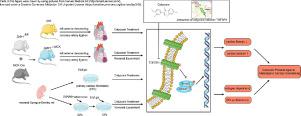Phytomedicine ( IF 6.7 ) Pub Date : 2022-06-15 , DOI: 10.1016/j.phymed.2022.154277 Guanghong Chen 1 , Honglin Xu 1 , Tong Xu 1 , Wenjun Ding 2 , Guoyong Zhang 1 , Yue Hua 3 , Yuting Wu 1 , Xin Han 1 , Lingpeng Xie 1 , Bin Liu 2 , Yingchun Zhou 1

|
Background
Excessive myocardial fibrosis is the pathological basis of heart failure following myocardial infarction (MI). Although calycosin improves cardiac function, its effect on cardiac fibrosis and cardiac function after MI in mice and its precise mechanism remain unclear.
Purpose
Here, we firstly investigated the effects of calycosin on cardiac fibrosis and ventricular function in mice after MI and the role of transforming growth factor-beta receptor 1 (TGFBR1) signaling in the amelioration of cardiac fibrosis and ventricular function.
Methods
In vivo effects of calycosin on cardiac structure and function in mice with MI induced by left anterior descending coronary artery ligation were determined by hematoxylin and eosin staining, Masson trichrome staining, and echocardiography. The molecular mechanism of the interaction between TGFBR1 and calycosin was investigated using molecular docking, molecular dynamics (MD) simulation, surface plasmon resonance imaging (SPRi), immunohistochemistry, and western blotting (WB). Subsequently, cardiac-specific Tgfbr1 knockout mice were used to verify the effects of calycosin. The effect of calycosin on primary cardiac fibroblasts (CFs) proliferation and collagen deposition was detected using cell counting (CCK-8), EdU assay, and WB in vitro. CFs infected with an adenovirus that encodes TGFBR1 were used to verify the effects of calycosin.
Results
In vivo, calycosin attenuated myocardial fibrosis and cardiac dysfunction following MI in a dose-dependent pattern. Calycosin-TGFBR1 complex was found to have a binding energy of -9.04 kcal/mol based on molecular docking. In addition, calycosin bound steadily in the cavity of TGFBR1 during the MD simulation. Based on SPRi results, the solution equilibrium dissociation constant for calycosin and TGFBR1 was 5.11 × 10−5 M. Calycosin inhibited the expression of TGFBR1, Smad2/3, collagen I, and collagen III. The deletion of TGFBR1 partially counteracted these effects. In vitro, calycosin suppressed CFs proliferation and collagen deposition after TGF-β1 stimulation by suppressing the TGFBR1 signaling pathway. The suppressive effects of calycosin were partially rescued by overexpression of TGFBR1.
Conclusion
Calycosin attenuates myocardial fibrosis and cardiac dysfunction following MI in mice in vivo via suppressing the TGFBR1 signaling pathway. Calycosin suppresses CFs proliferation and collagen deposition induced by TGF-β1 via inhibition of the TGFBR1 signaling pathway in vitro.
中文翻译:

毛蕊花素通过抑制 TGFBR1 信号通路减少心肌纤维化并改善心肌梗死后小鼠的心脏功能
背景
心肌过度纤维化是心肌梗死(MI)后心力衰竭的病理基础。毛蕊花素虽然改善了心功能,但其对小鼠心梗后心脏纤维化和心功能的影响及其确切机制尚不清楚。
目的
在这里,我们首先研究了毛蕊花素对 MI 后小鼠心脏纤维化和心室功能的影响,以及转化生长因子-β 受体 1 (TGFBR1) 信号在改善心脏纤维化和心室功能中的作用。
方法
通过苏木精和伊红染色、Masson 三色染色和超声心动图确定毛蕊花素对左冠状动脉前降支结扎诱导的 MI 小鼠心脏结构和功能的体内影响。使用分子对接、分子动力学 (MD) 模拟、表面等离子共振成像 (SPRi)、免疫组织化学和蛋白质印迹 (WB) 研究了 TGFBR1 和毛蕊花蛋白之间相互作用的分子机制。随后,使用心脏特异性Tgfbr1敲除小鼠来验证毛蕊花素的作用。使用细胞计数 (CCK-8)、EdU 测定和体外WB 检测毛蕊花素对原代心脏成纤维细胞 (CFs) 增殖和胶原沉积的影响. 感染了编码 TGFBR1 的腺病毒的 CF用于验证毛蕊花素的作用。
结果
在体内,毛蕊花素以剂量依赖的方式减轻 MI 后的心肌纤维化和心脏功能障碍。基于分子对接,发现 Calycosin-TGFBR1 复合物具有 -9.04 kcal/mol 的结合能。此外,在 MD 模拟过程中,calycosin 稳定地结合在 TGFBR1 的空腔中。基于 SPRi 结果,毛蕊花素和 TGFBR1 的溶液平衡解离常数为 5.11 × 10 -5 M。毛蕊花素抑制 TGFBR1、Smad2/3、I 型胶原蛋白和 III 型胶原蛋白的表达。TGFBR1 的删除部分抵消了这些影响。体外, calycosin 通过抑制 TGFBR1 信号通路抑制 TGF-β1 刺激后的 CFs 增殖和胶原沉积。TGFBR1 的过表达部分地挽救了毛蕊花素的抑制作用。
结论
Calycosin通过抑制 TGFBR1 信号通路在小鼠体内减轻 MI 后的心肌纤维化和心脏功能障碍。Calycosin在体外通过抑制 TGFBR1 信号通路抑制由 TGF-β1 诱导的 CFs 增殖和胶原沉积。











































 京公网安备 11010802027423号
京公网安备 11010802027423号